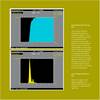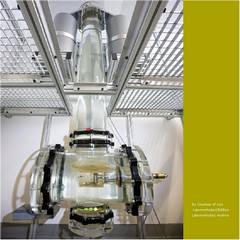- Details
- Last Updated on Friday, 13 January 2017 09:23
| Jiří Březina – Founder of GranoMetry™ – Science with Applications |
My precepts of sand sedimentology
I began my research in sand sedimentology 60 years ago, searching for oil and gas reserves in marine sand deposits. Having been so intimately involved with these practical applications, my research led me to realize that:
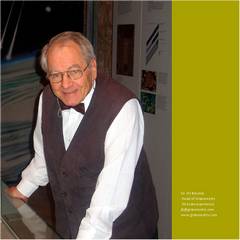
-
Only the hydrodynamic regime — transitional between the viscous flow (Stokes' law) and turbulent flow (Newton's law) — modifies the sediment granularity (dispersity). Its finest dispersity gradation reflects the sediment's origin (genesis).
-
Normal distribution components should replace distribution moment descriptors, because the components show the origin of a distribution mixture. (more...)
To that new approach, I assigned my trade mark GranoMetry™ — a composite word meaning measuring (Greek "metron" — to measure) and the Latin "granum" — grain, particle.
Success through Technology and Computers
Since nearly the inception of my instruments, I have incorporated computers and the latest technology in their design. Beginning with an analogue processing in 1963 (Clary DE 600 in 1968), I progressed to digital equipment in 1973; GranoMetry™ now offers advanced PC-controlled instrumentation for all of our products. Computerized instrumentation enabled solutions previously not imaginable to scientists, researchers, and industry alike. This uncompromising approach has resulted in success for users of my products.
(Photo: By Courtesy of Lois Lammerhuber/Edition Lammerhuber, Austria)
Science with Applications
During my studies in 1955-1968 at Central Geological Survey (UUG) of Czechoslovakia on marine deposits (with a maximum thickness of more than 5 km) from the Miocene age (23 to 5 million years ago) in the West Carpathian Mountain system, the territory of Moravia and Slovakia, I encountered great quantities of monotonous sandy deposits. In order to characterize them, distinguish sedimentation units and facies, and reconstruct their sedimentation basins with provenance issues, I sought distinctive features of the sands, especially after the standard micropaleontological tools (foraminifera) had failed. Unfortunately, even minerals and their chemistry failed.
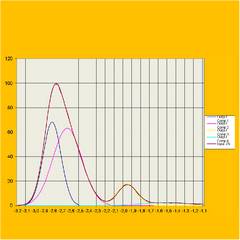 The only property of sand, which could reveal the sought features, was the sand granularity — better to say, dispersity — described by the statistical distribution of a suitable dispersity unit. Working on my PhD, I found that in fluid-deposited sands, the negative skewness of their PHI-size distribution disappears when the log settling velocity is taken as the dispersity unit (J. BREZINA, 1963).
The only property of sand, which could reveal the sought features, was the sand granularity — better to say, dispersity — described by the statistical distribution of a suitable dispersity unit. Working on my PhD, I found that in fluid-deposited sands, the negative skewness of their PHI-size distribution disappears when the log settling velocity is taken as the dispersity unit (J. BREZINA, 1963).
Only grain size distribution, determined by sieving, was available as a standard method. This is why I started developing a sedimentation technique. First, I hoped that the just published settling tube — such as the Woods Hole Rapid Sediment Analyzer (1960) — could be used. However, after I developed a highly sensitive pressure sensor for this type of settling tube, this method hit its limit — it required such a high suspension concentration that it caused significant errors from streaming and particle interaction. My pressure sensor was so sensitive that even a low spoken voice interfered with the measured signal. The reason was simple: particle frequency measured by the suspension density (pressure difference) was dependent on the suspension concentration and required it. Instead, only the sediment amount (weight) should be measured, i.e. without water (measuring of solids only could reduce the particle concentration).
Measuring Particle Weight instead of a Suspension Pressure Difference
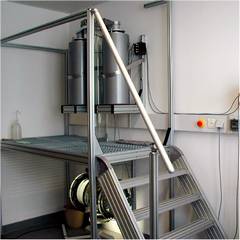 So I started developing a sensitive and fast underwater balance. My design consisted of steel leaf springs arranged in a parallelepiped to compensate for asymmetric load (German patent 2251838, BREZINA 1972). To allow for the optimum balance operation, I isolated it from environmental vibration and passed its output through a mathematical filter. To limit the concentration effects up to the upper 5 cm of the sedimentation column, I constructed a sample introduction device, which disperses the sample in the settling tube top: an electrically driven Venetian blind with eccentrically rotating concave lamellae, vibrate in the open position about 3 seconds. Experimental studies of sand suspension sedimentation, its streaming and particle interaction with a high speed camera enabled me to find a mathematical relationship for the optimum particle concentration. I materialized these results in the design of a unique Sand Sedimentation Analyzer, MacroGranometer™.
So I started developing a sensitive and fast underwater balance. My design consisted of steel leaf springs arranged in a parallelepiped to compensate for asymmetric load (German patent 2251838, BREZINA 1972). To allow for the optimum balance operation, I isolated it from environmental vibration and passed its output through a mathematical filter. To limit the concentration effects up to the upper 5 cm of the sedimentation column, I constructed a sample introduction device, which disperses the sample in the settling tube top: an electrically driven Venetian blind with eccentrically rotating concave lamellae, vibrate in the open position about 3 seconds. Experimental studies of sand suspension sedimentation, its streaming and particle interaction with a high speed camera enabled me to find a mathematical relationship for the optimum particle concentration. I materialized these results in the design of a unique Sand Sedimentation Analyzer, MacroGranometer™.
To convert the settling velocity into grain size and vice versa, I developed a universal sedimentation equation (BREZINA 1978, PARTEC) valid for fine particles (Stokes' law), coarse particles (Newton's law), the intermediate range and not only for spheres but also for irregular natural particles their shape is specified by Corey's Shape Factor, SF (COREY 1949, independently McNOWN and J. MALAIKA, 1950). The particle shape of sand particles has great influence onto the settling velocity. In the equation, it is much better to take the average shape of SF'=0.65 than the hydrodynamic shape of smooth sphere, SF'=1.18 (the hydrodynamic shape SF'=1.0 is valid for isometric bodies, such as cube).
Finally, I revised the distribution characteristics: I found that only Gaussian distribution and first two moments have physical meaning, whereas the higher (3rd and 4th) moments do not. I decomposed the measured distributions into a few (up to 5) Gaussian components using the program with unique algorithm by Isobel CLARK (1977, ROKE). The first two moments and percentages of each of the Gaussian component define sufficiently each sample (click).
To study the settling velocity sand fractions, I developed a Sand Sedimentation Separator™, 3S™. This instrument, when used for separation of equal-sized grains, such as sieve fractions, can separate the grains into fractions of the same density, which is unique for separating heavy minerals and microfossils, such as foraminifera.
This way, I completed a system of both hardware and software for the efficient study of sand dispersity. The distribution components of settling velocities indicate also those of the horizontal stream motion and thus enable to reconstruct the sedimentation basins. Because all my 14.000 samples I processed and archived in the years 1955 through 1968 have been discarded, I initiate a new study of Miocene sands on Moravia.
Applications in  geology:
geology:
• petroleum geology & basin analysis through facial and stratigraphic correlation; reservoir evaluation; enhanced recovery, heavy oil & tar sand production
• micropalaeontology & stratigraphy — isolation of porous microfossils, such as foraminifers & conodonts; correlation by finest textural features
• prospecting for heavy mineral (placer) deposits, such as gold, platinum group minerals, rare earth minerals, diamond, titanium & tin ores, zircon, garnets (see Distribution Decomposition)
oceanography:
• coastal processes & protection studies
• tracing sand movement, particularly due to longshore currents (litoral drift) through mixed distribution components
ecology:
• coastal protection, slope protection, ground water & contamination modeling, capillary barriers, permeability prediction, etc.
mechanical & chemical engineering (in German: mechanische Verfahrenstechnik):
• dispersity analyses of sand-sized materials in chemical industry
quality control:
• abrasives such as diamond, corundum, silicon carbide, boron nitride
• filter & foundry sands — sedimentational grain characteristics correlate with those of permeability because they are consistently related to specific surface (in contrast to sieve grain characteristics)
forensic research & analysis:
• identification of small sand samples (as small as 0.1 g) — by Gaussian distribution components, like finger imprints and DNA to identify a person
astronomy:
• dispersity (size) sand analyses of disintegrable space material such as meteorites (chondrites), comets and asteroids, and collected coarse (sand-sized) interplanetary dust
• dispersity (settling velocity) analyses of wind-blown and water deposited sands from Mars – no more science fiction …
Jiri Brezina — teaching over 7000 students in 37 years
 University of Maryland University College Europe
University of Maryland University College Europe
Physical Geology and Physical Geology LAB —GEOL-100/110
Environmental Geology — GEOL-120
Physical Science and Physical Science LAB — NSCI-100/110
Intro to Astronomy and Astronomy LAB — ASTR-100/110
Charles University, Faculty of Natural Sciences, Geology
Planetology for Geologists — taught according to the textbook written by Jiri Brezina
Jiří Březina — Thoughts
 The basic life memento is truth. Lie is an error, therefore a loss of time, which we have so little since our birth — what is the witness of hundred revolutions of our planet around a star, which we call a century against the existence of the world.
The basic life memento is truth. Lie is an error, therefore a loss of time, which we have so little since our birth — what is the witness of hundred revolutions of our planet around a star, which we call a century against the existence of the world.
Unfulfilled promise is kind of a lie, a falsehood, unfortunately intentional, though it follows from inexperience. But our inexperience does not help the matter:-we are responsible for our words, even death cannot excuse. So the next life memento is responsibility and reliability.
The next life memento is seeking: it became inherited already in the first self-replicating RNA molecules — precursors of life. Already these life precursors, to get along the environment, had to passively observe and humans to actively ask — a learning process, which enables finding and knowing.
Knowing enables and requires doing and includes responsibility.
Reaching a goal does not need to be a success: it may be very destructive. A very common extinction reason of a species had been its success.
To quantify the world, we compare its components with a scale. However, each scale depends on own quantity: each size, amount, duration have own scaling, each can only be properly evaluated if compared relatively, which means a logarithmic scale. Such as the Weber-Fechner law in physiology.
Booklet "Jiří Březina — Founder of GranoMetry — Science with Applications": e-book here and pdf book






